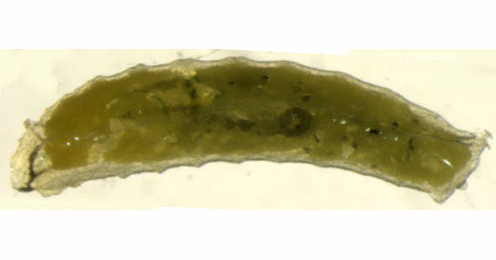|
||||||
|
Liriomyza
demeijerei Hering, 1930 Liriomyza
demeijerei Hering, 1930b. Z. angew. Ent. 17(2):
443 |
||||||||||||||||||||||||||||||||||||||||||||||||||||||||||||||
|
Leaf-miner: Generally associated with mid-rib or leaf margin and relatively long (Spencer, 1976: 243). Upper-surface corridor, generally descending from the tip of a leaf segment toewards the centre along a vein or the leaf margin. Frass in strings. Pupation outside the mine (Bladmineerders van Europa). An upper surface gallery of moderate length, mostly alongside a vein. The corridor is long and loose, with stringy frass (British leafminers). Larva: The larvae of flies are leg-less maggots without a head capsule (see examples). They never have thoracic or abdominal legs. They do not have chewing mouthparts, although they do have a characteristic cephalo-pharyngeal skeleton (see examples), usually visible internally through the body wall. Posterior spiracles of the larva with 3 bulbs (Bladmineerders van Europa).
Puparium: The puparia of flies are formed within the hardened last larval skin or puparium and as a result sheaths enclosing head appendages, wings and legs are not visible externally (see examples). Yellow; posterior spiracles each with 3 bulbs (Spencer, 1976: 243). Hosts in Great Britain and Ireland:
Hosts elsewhere:
Time of year - mines: Bivoltine: summer and autumn (British leafminers). Time of year - adults: Currently unknown. Distribution in Great Britain and Ireland: Uncommon. London (Hampstead) (Spencer, 1972b: 57), Hampshire (Fleet) (British leafminers) and Warwickshire (Coventry) (Robbins, 1991: 118); Cambridgeshire, East Suffolk and South-west Yorkshire (NBN Atlas). Distribution elsewhere: Widespread in continental Europe (Spencer, 1990) including Denmark, Finland, Sweden (Spencer, 1976: 243), The Netherlands, Luxembourg (Bladmineerders van Europa), Belgium (de Bruyn and von Tschirnhaus, 1991), Germany (Spencer, 1976: 243), Czech Republic, French mainland, Italian mainland, Lithuania, Poland and Sicily (Fauna Europaea). NBN Atlas links to known host species:
British and Irish Parasitoids in Britain and elsewhere:
|
| Last updated 09-Jul-2019 Brian Pitkin | ||

